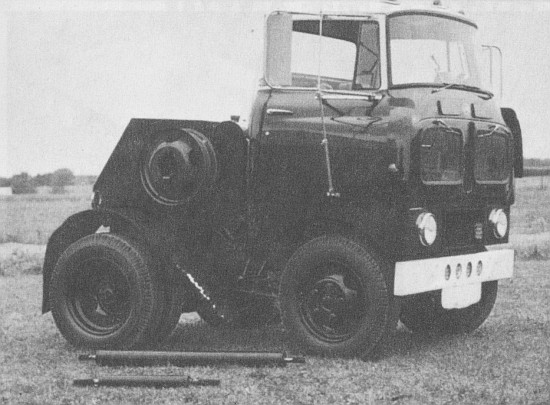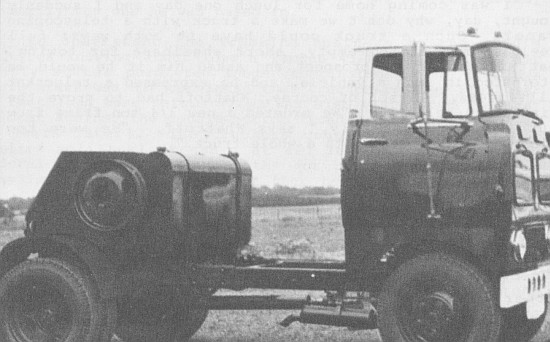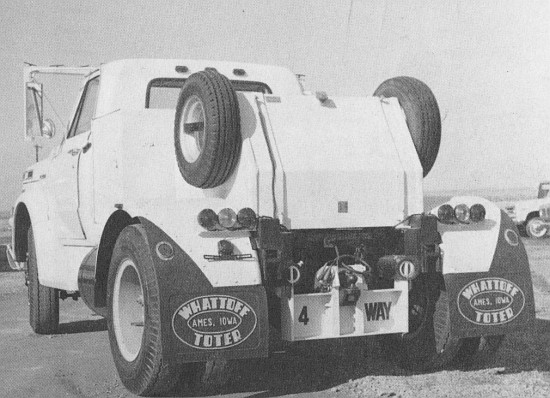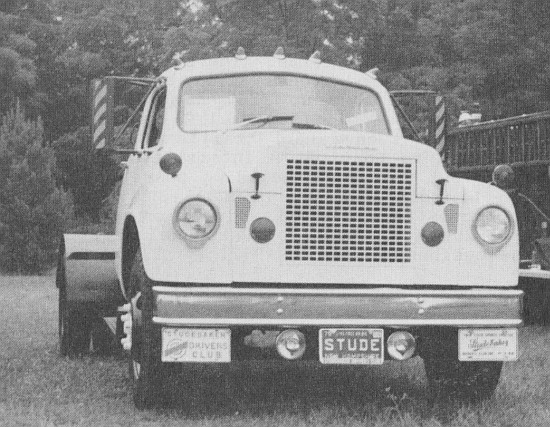
Whattoff's own make Toter 8 made from
the short International Sightliner Cab
Note the different length driveshafts.


Whattoff's own make Toter 8 made from
the short International Sightliner Cab
Note the different length driveshafts.

There was another group of 25 Toter 8's built between 1962 and 1965 on a special chassis. These jobs were own make Whattoffs, and used Studebaker, International, or Detroit engines with the International Sightliner cab. That cab, once seen never forgotten, had a remarkable 48" overall length bumper to back of cab, and the operator has the feeling that he is driving a window. In a very real sense, the driver is the first thing to get hit in one of these cabs, and they were not a commercial success for International. But, Boy! Were they short. And about this time things began to happen that changed the nature of the Trailer Toter business.
The first was minor: the name was changed to Whattoff Toter. (Remember, Trailer meant trailer park.) The next was far more important: Studebaker went into the toter business.

Chevrolet C-65 427 15-foot Toter, 1973
Note the full range of equipment: storage
box, trailer spare tires,
4-Way Hitch with height adjustment, adjustable
front mirror
The toters were doing well enough that they decided it would be good for them to build it themselves, recalls Vernard Whattoff. They never asked us about it; they had Bock do it in Elkhart. Whattoff and Bock were not strangers; Whattoff had a sales and service branch in Elkhart (then, as now, the heart of the trailer -- er, mobile home industry, with something like 160 factories in the immediate 2-state vicinity during the glory days). Bock himself had done some mild conversions similar to those done by Whattoff. He actually made light of our work, to tell you the truth. And Elkhart was, of course, closer to South Bend. But still: was this a crummy trick to pull on your biggest dealer, or what? I don't think they treated us very well, agrees Vernard. The greatest exposure they had to the toter business was through their Ames dealer. but they decided they wanted to build them -- and instead of coming to us they went to Elkhart. The Whattoff copies, of course, were just that: copies. What about infringement suits? Our family lawyer had handled all our stuff, and he muffed it on the adjustable frame, so we had no patent, no protection. We went to a patent lawyer in Des Moines for our 4-way adjustable hitch; the hitch is still selling, so we have had some royalties over the years.

| The official Studebaker toter - a 1964 8 E 28 converted by Bock in Indiana. This restored truck is presently owned by Don and Anne Richards of Mason, New Hampshire. The photo was taken by George and Bee Hamlin at the 1978 International SDC Meet at South Bend. |
In the end it didn't matter much whether Bock, or Studebaker, or anybody else, was making counterfeit Studebaker/Whattoff Trailer Toters, because the third development was when Studebaker quit the truck business.
Whattoff had, of course, the International line and the expertise to build Toters on anything after Studebaker quit trucks. And there was still the ability to do original thinking. The 4-way hitch, the first telescoping mirror (mounted on two square tubes across the front of the cab), leaf springs mounted on one end in a coil-spring box to take care of the hard riding problem when riding empty, a remarkable quick-change ball held in place by removable wedges -- We tried a lot of things -- and a matchless nationwide reputation, particularly in the Midwest and the East, gave Whattoff Motors, soon Whattoff Industries, the basis for continuing even stronger than before. There was a new Toter available, a special 60-inch job on the International 1710 cab-over-engine; the hitch was within inches of the engine, way down under the cab. Customers from all over wanted Toters, and the business outgrew the quarters on West Lincoln Way.
We were really crowded by 1969, says Don Whattoff. We either had to stop the growth or enlarge. We had the Toters, we had Simca for a while, and we had Toyota. We were partners on the west end, but we decided the best thing to do was split up. I stayed out on the west end, and I ended up with Toyota and Dodge. Vernard took the Toters to the new location. And the Whattoff Toter business was really poised to hit the big time. The state was relocating U.S. 30 onto a new limited access superslab south of town, and Interstate 35 had come up from Kansas City and Des Moines, headed for Minneapolis/St. Paul a few years before. A Toter dealership at such a high-traffic interchange would be perfectly suited to Whattoff's interstate clientele, and Vernard Whattoff put up a huge building there. Whereas his production on Lincoln Way had been 25-30 jobs per month under normal circumstances, the new location would give him the capacity of 2000 jobs yearly. Personnel went from 10-12 to 60-70. The business moved in 1972.
The timing could not have been worse.